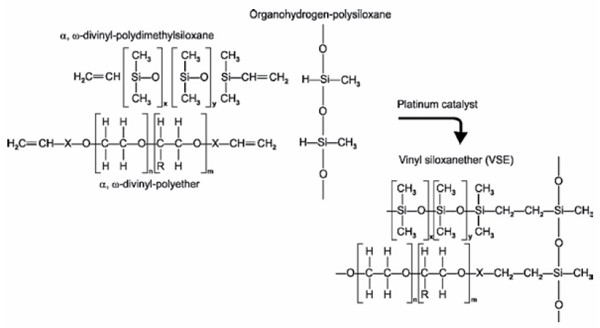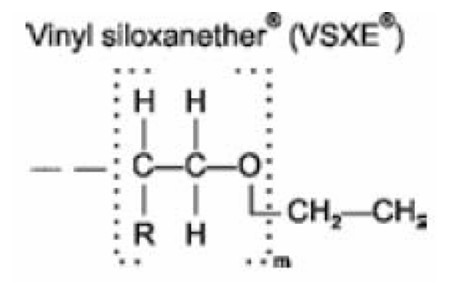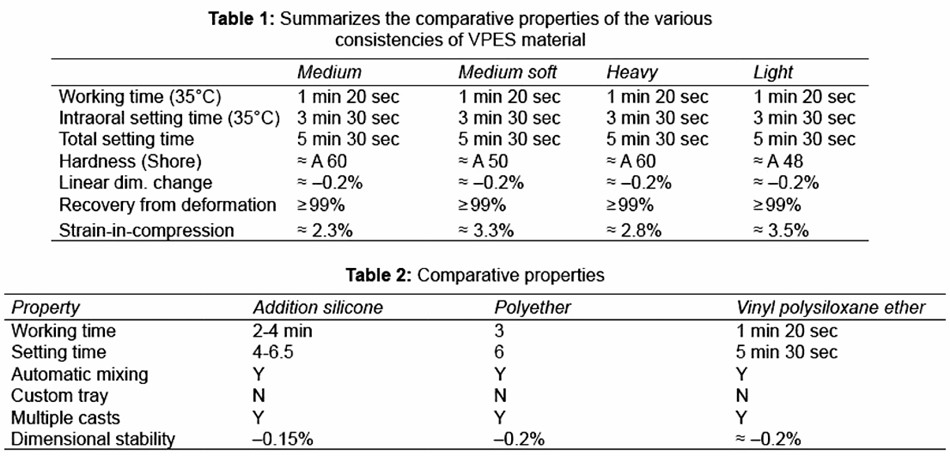

A precise impression is crucial for ensuring a perfect fit of indirect restorations. However, for many clinicians, obtaining an accurate impression for fixed prostheses remains one of the most challenging aspects of restorative dentistry, despite advances in elastomeric materials. The effectiveness of newly developed elastomeric polymer Vinyl Polyether Siloxane, which combines the properties of polyether and polyvinyl siloxane (PVS) elastomers, has been a subject of interest in recent studies. This review aims to elucidate the material properties of vinyl polyether siloxane through a comprehensive analysis of current scientific literature.
Key words: vinyl polyether siloxane, polyether, polyvinyl siloxane, elastomeric impression materials, fixed prostheses
An accurate impression is the first most important
step in the procedure of obtaining a perfect
restoration. It is the aim of the impression to
produce a dimensionally stable ‘negative’ which
can serve as a mold for a cast.1
The accuracy of impression materials is crucial
for producing a well-fitting definitive restoration,
relying on both dimensional stability and
detailed reproduction. Various factors affect the
dimensional accuracy, including periodontal
health, oral hygiene, technique, tray selection,
and material properties. Additionally, the
material’s ability to flow and conform to oral
tissues, as well as its capacity to properly wet
moist surfaces, plays a key role in achieving a
precise impression. Any inaccuracies during
this process can lead to errors when transferring
information to the dental laboratory, ultimately
compromising the fit and adaptation of the final
restoration.2
Among available elastomeric materials, the
vinyl polysiloxanes (VPS) and polyethers (PEs)
are used most frequently.3 Traditional additional
silicones were hydrophobic; due to which
accuracy of impressions was questionable.
The newer ones have added surfactants to
counteract this. Polyether, on the other hand, is
hydrophilic and records good detail, but it is the
stiffest among all elastomers.1
Combining Polyether (PE) with Polyvinyl
Siloxane (PVS) to create hybrid materials offers
several mechanical advantages. Due to the
similar mechanical properties of both materials,
this combination can enhance tensile and tear
strength. The synergistic effect may improve
performance in dental impressions, where
flexibility and durability are essential.4 This newer
elastomer that has been developed is called
as vinyl polyether siloxane (VPES) combining
features of both addition silicone and polyether
were commercially introduced in 2009 as
stated. This new elastomer boasts of immediate
hydrophilicity, at the same time combining
favorable characteristics of both polyether and
vinyl polysiloxane.1 This article aims to explore
new impression material that are both effective
and efficient in achieving predictable, accurate,
and high-quality impressions in dental practice.
In the 1950s, polysulfides and condensation
reaction silicones (C-type silicones) were reliably
used in fixed prosthodontics. In the late 1960s,
polyether, a hydrophilic material cured by cationic
ring-opening polymerization, was introduced.
With its excellent mechanical properties, good
elastic
recovery, and minimal shrinkage,
polyether outperformed hydrocolloids and
C-type materials. A decade later, hydrophobic
addition-cured silicones, or poly(vinyl siloxane)
(PVS), were introduced, with their hydrophobicity
reduced by adding surfactants. PVS is renowned for its high dimensional stability across time
and temperature, as well as its superior
elastic recovery, even in moist environments.
According to Christensen in 1997, “The past 20
years have brought significant improvements
in both polyether and PVS categories, making
them the most widely accepted materials for
prosthodontic applications.” By 1997, the three
dominant categories of impression materials for
fixed, removable, and implant prosthodontics
were addition reaction silicones, polyether, and
reversible hydrocolloid, in that order of usage.1
A novel impression material, Vinyl Polyether
Siloxane (VPES), has recently been developed
through extensive research and testing of various
properties. This innovative hybrid combines the
hydrophilic characteristics of polyether with the
dimensional stability and elastic recovery of
polyvinyl siloxane (PVS), resulting in a material
that offers superior flow, tear strength, and
accuracy in moist environments without the need
for surfactants.
It is a new chemical compound developed by
combining polyether polymer and vinyl groups
of VPS as shown in the figures below.1

Figure showing Vinyl polyether siloxane
molecule below:1

The properties of vinyl polyether siloxane (VPES)
material and comparisons between VPES,
addition silicone and polyether are summarized
in Tables 1 and 2.1

The Vinyl Polyether Siloxane (VPES) impression
material is designed exclusively for the one-step
multiple-mix technique, ensuring optimal results
in dental impressions. This technique involves
the use of a custom tray and the simultaneous
application of two viscosities: heavy body and light body materials. The heavy body is placed
in the tray, while the light body is injected around
the prepared tooth to capture fine details. The
combination of these viscosities allows for
accurate tissue recording and a precise fit for
definitive restorations.
Some of the specific indications according to
viscosity are listed below.1
Medium Viscosity
Heavy Viscosity
Light Viscosity
Dimensional Stability
Stober et al evaluated a study on the Accuracy
of newly formulated fast-setting elastomeric
impression materials and stated that vinyl
siloxanether monophase impressions and vinyl
siloxanether dual-viscosity impressions display
acceptable accuracy for clinical use with
immersion disinfection, since the results for vinyl
siloxanether were comparable to the results for
representative polyether and vinyl polysiloxane
materials.10
Techkouhie A et al conducted a study on Surface
detail reproduction of elastomeric impression
materials related to rheological properties
suggest that PVS has the smallest change
(−0.15%), followed by polyether (−0.2%). The
vinyl siloxane ethers have a dimensional change
of ≈ –0.2% which is acceptable.11
Nassar U et al evaluated the dimensional stability
of vinyl polyether silicone (VPES) impressions as
a function of delayed-pouring time for up to 2
weeks after performing a recommended clinical
disinfection procedure. It was concluded that the
Casts produced from a disinfected regular set
VPES (EXA’lence 370 monophase) demonstrated
excellent dimensional stability at different pour
times and were comparable to the tested VPS
and PE impression materials.5
Surface detail reproduction
Rabeeba PK et al compared and evaluated
the surface detail reproduction and effect of
disinfectant and long-term storage for 2 weeks
on the dimensional stability of hybrid material
Vinyl polyether silicone (VPES) with its parent
Polyvinyl siloxane (PVS) and Polyether (PE)
impression materials and the results concluded
that the newer material VPES was observed to be both dimensionally stable and capable of
producing good surface detail reproduction.2
Tear strength
Tear strength is influenced by the chemical
composition, consistency, and manner of removal
of material. A rapid rate of force application
during removal usually increases the tear
strength. Pandey P et al evaluated a study on
Mechanical Properties of a New Vinyl Polyether
Silicone in Comparison to Vinyl Polysiloxane
and Polyether Elastomeric Impression Materials
and the results indicated that the tear strength
of vinyl polyether siloxane was better than
polyether and vinylpoly siloxane.3
Tensile strength
Pandey P et al evaluated a study on Mechanical
Properties of a New Vinyl Polyether Silicone in
Comparison to Vinyl Polysiloxane and Polyether
Elastomeric Impression Materials and the results
indicated that the new vinyl polyether silicone
had better tensile strength than polyether.3
Flexibility
Vinyl polyether siloxane tested was found to
be more flexible with high tensile energy in a
study evaluated by Pandey P et al. This material
can be preferred in cases with undercut areas
favoring the removal of impressions without tear
and distortion.3
Effect of Disinfectant
Rabeeba PK et al compared and evaluated
the surface detail reproduction and effect
of disinfectant and long-term storage for 2
weeks on the dimensional stability of hybrid
material Vinyl polyether silicone (VPES) with its
parent Polyvinyl siloxane (PVS) and Polyether
(PE) impression materials. According to the
disinfection guidelines, it is suggested that
addition silicone impressions can be disinfected by immersion without affecting its accuracy
and surface detail reproduction. Surface detail
reproduction is observed to be enhanced by
the use of 2% acidic glutaraldehyde solution.
In the present study all the impressions were
disinfected in 2.45% glutaraldehyde solution
for a duration of 30 minutes whereas the non
disinfected ones were kept in distilled water for
30 minutes. Among the disinfected groups Vinyl
polyether silicone showed the least dimensional
changes on 0 day, 7 days and 14 days of storage
compared to polyvinylsiloxane and Polyether.2
Hydrophilicity
The hydrophilic or wettable characteristics
of impression materials also contribute to
passively fitting impressions. The hydrophilicity
was measured by determining the contact
angle of a drop of water on the material under
observation. Singer et al. reported that PVES
demonstrates improved hydrophilicity and
wettability compared to PE and PVS, and these
observations were also consistent with other
studies.4 Heuttiget al. reported the highest
hydrophilicity of PVES, with a mean contact
angle of 16.8° among eight samples.12
Surface quality
Rabeeba pk et al conducted a clinical
comparison of quality of vinyl polyether silicone
impressions with polyvinyl siloxane impressions
using one-step impression technique and the
results showed that the new hybrid material vinyl
polyether silicone displayed acceptable surface
quality and handling properties for clinical use
using one-step impression technique.6
Vinyl polyether siloxane represents the dawn
of the next generation of materials, overcoming
the drawbacks of all previous impression
materials. This systematic review provides a clear understanding of the properties of novel
vinyl polyether siloxane hybrid impression
materials. Vinyl polyether siloxane
has
significantly better tensile strength and provides
impressions with fewer defects compared to
polyether and Polyvinylsiloxane. Vinyl polyether
siloxane exhibited better wettability and contact
angle with water than Polyvinyl siloxane and
Polyether. This makes it an excellent alternative
to Polyvinylsiloxane, in which moist conditions
are prevalent in the clinical setting. This makes
vinyl polyether siloxane the preferred material
for dental impressions. It can be concluded
that vinyl polyether siloxane hybrid elastomers
eliminate the drawbacks of Polyether and
Polyvinylsiloxane, providing a novel impression
material with superior tensile strength,
hydrophilicity, and dimensional accuracy in one
place. It is also worth noting that vinyl polyether
siloxane exhibits satisfactory elastic recovery
and detailed reproduction, as individual studies
indicate. However, further researches can be
done for a more detailed analysis of all the
properties.